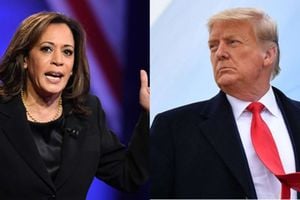Prime
NRM can’t lead in displacement of Uganda’s pre-capitalist structures

Former NRA rebel leader Yoweri Museveni (2nd right) swears in as President in January 1986. Photo/FILE
What you need to know:
- National democratic liberation is the replacement of pre-capitalist structures, institutions and ideology with a semblance of bourgeois institutions and ideology. Pre-capitalist institutions such as traditional kingdoms and the accompanying ideology has to be eradicated. But President Museveni does not agree.
In a recent epistle in New Vision, senior presidential advisor in-charge of political affairs David Mafabi made a number of startling statements on national democratic liberation.
“This is the phase of the Ugandan new (or national) democratic revolution… It is a revolution to resolve new (national) democratic tasks… Meaning it touches on questions of national unity, national independence, social justice and social progress… For comparative theoretical frameworks, the national democratic revolution postulation of the ANC of South Africa is instructive… As is Mao Zedong’s postulation on new democratic revolutions in the backward peasant former colonies,” Mafabi wrote.
Notwithstanding Mafabi’s intellectual sounding write-up, the ruling National Resistance Movement (NRM) cannot implement a national democratic programme. By the composition of its leadership, it is anti-national democratic liberation by nature and so it is an impossible task for it to take. Moreover, the middle name for the NRM is resistance. Mafabi should ask himself: what are they resisting if not national democratic liberation?
National democratic liberation is equivalent to the bourgeois democratic revolution that occurred in Europe after the replacement of feudalism by the bourgeoisie capitalist system. At that time the feudal institutions and ideology were replaced by bourgeois institutions and ideology.
In our case, national democratic liberation is the displacement of pre-capitalist structures, institutions and ideology by a semblance of bourgeois institutions and ideology. It also is the displacement of pre-colonial dominance by some degree of equality.
In places where caste systems obtained like in Ankole, national democratic liberation means the eradication of Hima dominance. Thus, for instance, because the leadership of the NRM was dominated by Bahima, NRM cannot set itself to prosecute national democratic liberation.
In Buganda both the pre-capitalist institutions such as the Kabakaship as well as the accompanying ideology has to be eradicated. Let us explain. The Kabaka and the accompanying paraphernalia are pre-capitalist institutions and that needed to be eradicated. President Museveni does not agree.
While the monarchy was abolished in 1966, Museveni in Sowing the Mustard Seed wrote: “By 1970, Obote had... overthrown the Constitution and traditional leaders in the region of Buganda, Ankole, and Bunyoro where some of them, especially in Buganda and Tooro, were very popular.” (Page 42-43)
Beyond that statement, Museveni was to restore the so-called traditional kingdoms. He also created kingdoms in areas where they had never existed.
Compare this record to that of UPC, the true instrument of national democratic liberation. The very first time the struggle for national liberation surfaced was at the 1964 UPC delegates’ conference. The struggle took the form of the contest for the post of party secretary general. The two contestants were John Kakonge (representing national democratic liberation) against Grace Ibingira (representing the forces against national democratic liberation).

Author: Yoga Adhola. PHOTO/FILE
The next time the two forces contended was in the events leading to the 1966 national democratic liberation. Leading the forces of national democratic liberation was Milton Obote, on the one hand, and, on the other hand, leading the forces against national democratic liberation was Ibingira.
It is again instructive to read from Sowing the Mustard Seed.
About when Ibingira and others were plotting against the government, Museveni wrote: “On February 22, 1966, the day he [Obote] arrested five members of his Cabinet, three of us – Martin Mwesigwa, Eriya Kategaya and myself – went to see James Kahigiriza, who was the Chief Minister of Ankole, to inquire about the possibility of going into exile to launch an armed struggle.
“Kahigiriza discouraged us, saying we should give Obote enough time to fall by his own mistakes. We saw him again a few weeks later and he gave us the example of former Ghana president Kwame Nkrumah, who had been overthrown in Ghana by a military coup two days after Obote’s abrogation of the Uganda Constitution. Kahigiriza advised us that Nkrumah’s example showed that all dictators were bound to fall in due course.
“Inwardly we were not convinced. We knew that dictators had to be actively opposed and that they would not just fall off by themselves like ripe mangoes. Later, I went to Gayaza High School with Mwesigwa to contact Grace Ibingira’s sister in order to find out whether she knew of any plans afoot to resist Obote’s dictatorship. She, however, did not know of any such plan. We came to the conclusion that the old guard had no conception of defending people’s rights and we resolved to strike on our own.” (Museveni, Y. 1997:19)
The reader should note that this quote began with the words: “We were staunchly anti-Obote.” Museveni does not give us the reason why they were staunchly anti-Obote. However, given the background of the three, it is not difficult to figure out.
Museveni himself tells us the background of the three: “I had been with Martin Mwesigwa since primary days in 1953. He was quite outstanding in school work and was head prefect at Ntare School. He came from a cattle keeping background like myself, but his father had been a sub-county chief in Ankole, which put him in a slightly different social group from ours. People who became chiefs tended more towards Christianity than ordinary ones. He was very gentle and mild-mannered, with a quiet sense of humour, but also very determined and courageous, which is how he had managed to join us. When we had political debates within our group, he put forward a lot of ideas but he was not as effervescent as I was.
“I had not known Mwesigwa Black for as long as I had known Martin. We had met at Mbarara High School. Mwesigwa was nicknamed ‘Black’ because he was very dark-skinned, but his real first name was William. Like Martin, he was quiet and mild-mannered. He was also from a cattle-keeping background and his parents were born-again Christians.
“By contrast, Valeriano Rwaheru was from a farming background, short and stocky, and he was Roman Catholic. He too was quiet but noticeably courageous in the skirmishes to come. He was, therefore, a very valuable person to have around in difficult times. All three of these men were to lose their lives in the 1970s, in the struggle against [Idi] Amin.
“Eriya Kategaya, whom I have known since our first year in primary school, is the only one of the four who is still alive today [Kategaya died in March 2013]. His origins are in a mixed background of cattle-keepers and cultivators. He is quiet and reserved, but enormously courageous, as he was to prove in his clandestine work in the years ahead.” (Museveni, Y. 1997: 17)
From this quote, it is clear that all the people mentioned were Bahima (or Bahima-related as in the case of Kategaya), a characteristic which Museveni seeks to obscure by calling it the cattle-keeping background.
In simple words, NRM cannot implement a national democratic programme.
Yoga Adhola is a leading ideologue of UPC.
[email protected]




